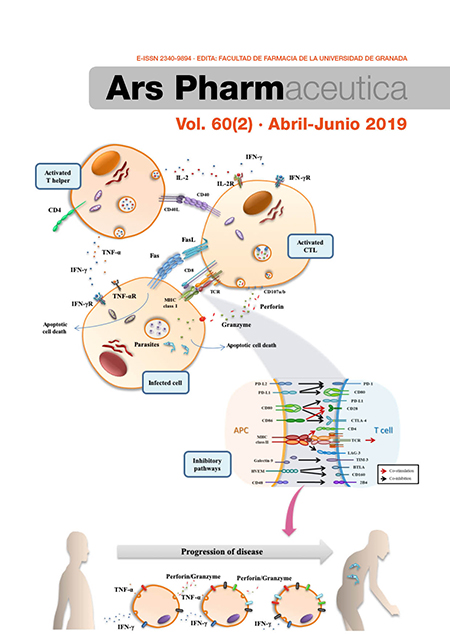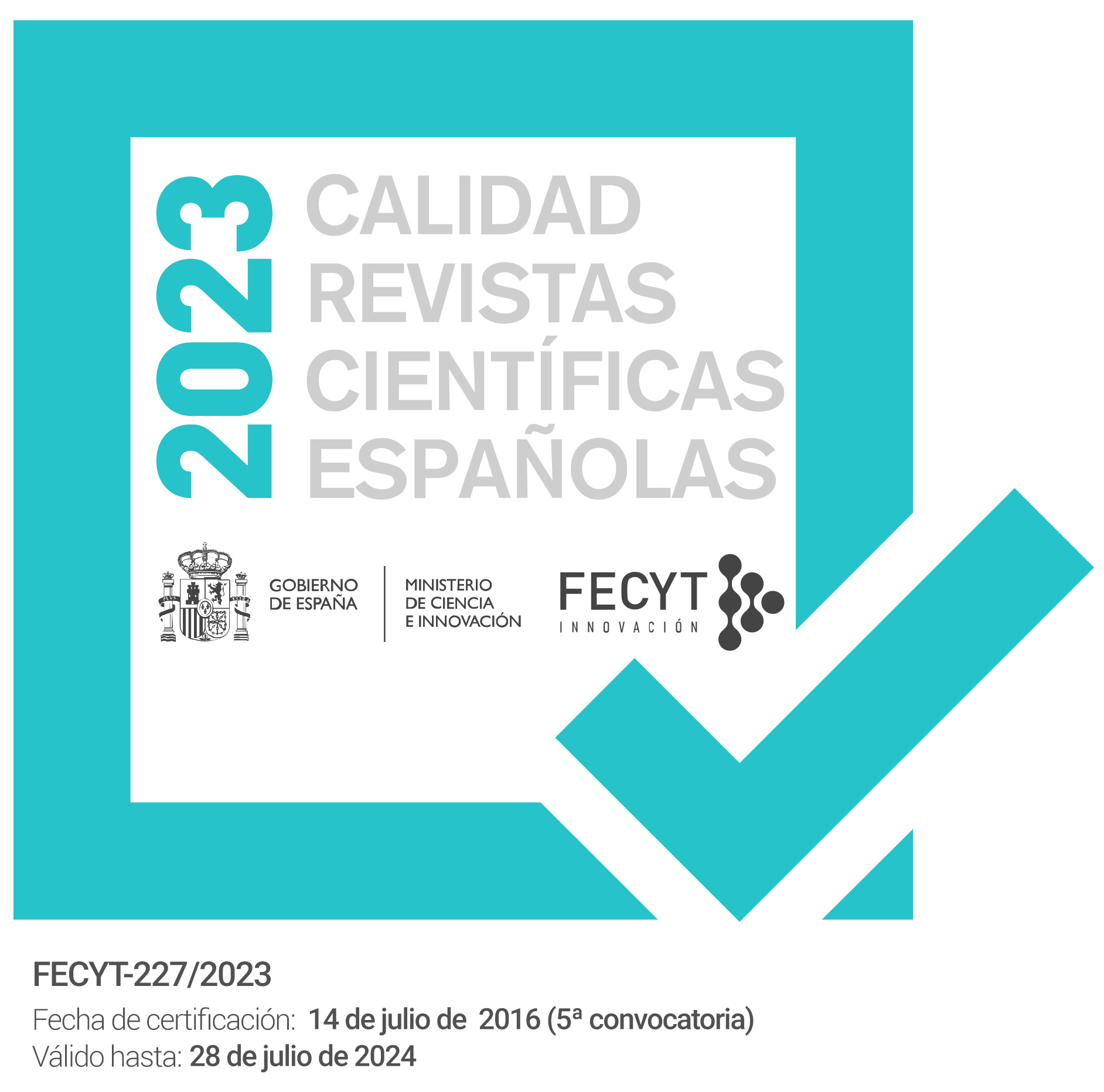Formulación y evaluación de ketoprofeno cargado de nanogel de quitosán para el manejo del dolor: estudio ex vivo e in vivo
DOI:
https://doi.org/10.30827/ars.v60i2.8563Palabras clave:
Parto transdérmico, ketoprofeno, nanogelResumen
Objetivo: El objetivo de este estudio fue desarrollar y evaluar un gel a base de nanoemulsión (nanogel) para el suministro transdérmico de ketoprofeno. Entre los diversos excipientes probados, se seleccionaron el ácido oleico, la mezcla de 80 y el etanol como aceite, surfactante y co-surfactante.
Métodos: La región de las nanoemulsiones se identificó mediante la construcción de diagramas de fase pseudoternarios utilizando la titulación de la fase acuosa. La nanoemulsión preparada se sometió a diferentes estudios de estabilidad termodinámica y la nanoemulsión que pasó las pruebas de estabilidad termodinámica se evaluó para determinar la viscosidad, el índice de refracción, el tamaño de las gotitas, la microscopía electrónica de transmisión y el estudio de permeación ex-vivo utilizando piel de cadáver humano
Resultados: Sobre la base de la evaluación, la formulación de C1, que consiste en 3.09% peso / peso de la fase oleosa, 60.54% peso / peso de Smix y 36.36% peso / peso de agua destilada se seleccionaron como una formulación optimizada y se convirtieron a nanogel utilizando quitosano como Un agente gelificante. Nanogel se evaluó para estudio ex-vivo e in vivo. El nanogel mostró un aumento significativo en la actividad antiinflamatoria en comparación con el gel convencional.
Conclusión: En conclusión, el nanogel podría ser un sistema prometedor para mejorar la administración transdérmica del ketoprofeno.
Descargas
Citas
Suzuki T, Shinoda M, Osanai Y, Isozaki T. Photochemical reaction of 2-(3-benzoylphenyl)propionic acid (ketoprofen) with basic amino acids and dipeptides. J Phys Chem B. 2013;117(33):9662–8.
Miller MA, Pisani E. The cost of unsafe injections. Vol. 77, Bulletin of the World Health Organization. 1999. p. 808–11.
Callaghan TM, Wilhelm KP. A review of ageing and an examination of clinical methods in the assessment of ageing skin. Part 2: Clinical perspectives and clinical methods in the evaluation of ageing skin. Vol. 30, International Journal of Cosmetic Science. 2008. p. 323–32.
Shakeel F, Baboota S, Ahuja A, Ali J, Aqil M, Shafiq S. Nanoemulsions as vehicles for transdermal delivery of aceclofenac. AAPS PharmSciTech. 2007;8(4):191–9.
Singh B, Singh R, Bandyopadhyay S, Kapil R, Garg B. Optimized nanoemulsifying systems with enhanced bioavailability of carvedilol. Colloids Surfaces B Biointerfaces. 2013;101:465–74.
Zhao JH, Ji L, Wang H, Chen ZQ, Zhang YT, Liu Y, et al. Microemulsion-based novel transdermal delivery system of tetramethylpyrazine: preparation and evaluation in vitro and in vivo. Int J Nanomedicine. 2011;6:1611–9.
Swarbrick J, Boylan JC. Encyclopedia of pharmaceutical technology. Vol. 20, Pharmaceutical Technology. 1996. 23-24 p.
Lawrence MJ, Rees GD. Microemulsion-based media as novel drug delivery systems. Vol. 64, Advanced Drug Delivery Reviews. 2012. p. 175–93.
Muxika A, Etxabide A, Uranga J, Guerrero P, Caba K De. International Journal of Biological Macromolecules Chitosan as a bioactive polymer : Processing , properties and applications. Int J Biol Macromol [Internet]. 2017;105:1358–68. Doi: 10.1016/j.ijbiomac.2017.07.087
S. A, S. I. Chitosan & its derivatives: A review in recent innovations. Int J Pharm Sci Res. 2015;6(1):14–30.
Azuma K, Izumi R, Osaki T, Ifuku S, Morimoto M, Saimoto H, et al. Chitin, Chitosan, and Its Derivatives for Wound Healing: Old and New Materials. J Funct Biomater. 2015;6(1):104–42.
Okamoto Y, Kawakami K, Miyatake K, Morimoto M, Shigemasa Y, Minami S. Analgesic effects of chitin and chitosan. Carbohydr Polym. 2002;49(3):249–52.
Pathan IB, Mallikarjuna Setty C. Nanoemulsion system for transdermal delivery of tamoxifen citrate: Design, Characterization, effect of penetration enhancers and in vivo studies. Dig J Nanomater Biostructures. 2012;7(4):1373–87.
Shafaat K, Kumar B, Das SK, Ul Hasan R, Prajapati SK. Novel nanoemulsion as vehicles for transdermal delivery of Clozapine: In vitro and in vivo studies. Int J Pharm Pharm Sci. 2013;5(SUPPL 3):126–34.
Soliman SM, Abdel Malak NS, El-Gazayerly ON, Abdel Rehim a a. Formulation of microemulsion gel systems for transdermal delivery of celecoxib: In vitro permeation, anti-inflammatory activity and skin irritation tests. Drug Discov Ther [Internet]. 2010;4(6):459–71.
Moreno MA, Ballesteros MP, Frutos P. Lecithin-based oil-in-water microemulsions for parenteral use: Pseudoternary phase diagrams, characterization and toxicity studies. J Pharm Sci. 2003;92(7):1428–37.
Shafiq S, Shakeel F, Talegaonkar S, Ahmad FJ, Khar RK, Ali M. Development and bioavailability assessment of ramipril nanoemulsion formulation. Eur J Pharm Biopharm. 2007;66(2):227–43.
Bhatt P, Madhav S. A detailed review on nanoemulsion drug delivery system. Int J Pharm Sci Res. 2011;43(2):2292–8.
Liu CH, Yu SY. Cationic nanoemulsions as non-viral vectors for plasmid DNA delivery. Colloids Surfaces B Biointerfaces. 2010;79(2):509–15.
Pathan IB, Munde SJ, Shelke S, Ambekar W, Mallikarjuna Setty C. Curcumin loaded fish scale collagen-HPMC nanogel for wound healing application: Ex-vivo and In-vivo evaluation. Int J Polym Mater Polym Biomater. 2018;
Fang JY, Sung KC, Lin HH, Fang CL. Transdermal iontophoretic delivery of diclofenac sodium from various polymer formulations: in vitro and in vivo studies. Int J Pharm. 1999;178(1):83–92.
Shakeel F. Criterion for excipients screening in the development of nanoemulsion formulation of three anti-inflammatory drugs. Pharm Dev Technol [Internet]. 2010;15(2):131–8.
Pathan IB, Jaware BP, Shelke S, Ambekar W. Curcumin loaded ethosomes for transdermal application: Formulation, optimization, in-vitro and in-vivo study. J Drug Deliv Sci Technol. 2018;44.
Pouton CW, Porter CJH. Formulation of lipid-based delivery systems for oral administration: Materials, methods and strategies. Vol. 60, Advanced Drug Delivery Reviews. 2008. p. 625–37.
Silva HD, Cerqueira MA, Vicente AA. Influence of surfactant and processing conditions in the stability of oil-in-water nanoemulsions. J Food Eng. 2015;167:89–98.
Arora P, Mukherjee B. Design, development, physicochemical, and in vitro and in vivo evaluation of transdermal patches containing diclofenac diethylammonium salt. J Pharm Sci. 2002;91(9):2076–89.
Tadros TF. Emulsion Formation, Stability, and Rheology. In: Emulsion Formation and Stability. 2013. p. 1–75.
Descargas
Publicado
Cómo citar
Número
Sección
Licencia
Los artículos que se publican en esta revista están sujetos a los siguientes términos en relación a los derechos patrimoniales o de explotación:
- Los autores/as conservarán sus derechos de autor y garantizarán a la revista el derecho de primera publicación de su obra, la cual se distribuirá con una licencia Creative Commons BY-NC-SA 4.0 que permite a terceros reutilizar la obra siempre que se indique su autor, se cite la fuente original y no se haga un uso comercial de la misma.
- Los autores/as podrán adoptar otros acuerdos de licencia no exclusiva de distribución de la versión de la obra publicada (p. ej.: depositarla en un archivo telemático institucional o publicarla en un volumen monográfico) siempre que se indique la fuente original de su publicación.
- Se permite y recomienda a los autores/as difundir su obra a través de Internet (p. ej.: en repositorios institucionales o en su página web) antes y durante el proceso de envío, lo cual puede producir intercambios interesantes y aumentar las citas de la obra publicada. (Véase El efecto del acceso abierto).
























